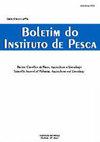在挖掘槽中养殖的商业切块的坦巴奎(巨形巨pomum Cuvier, 1818)的脂肪酸谱、欧米茄和脂质
IF 0.6
4区 农林科学
Q4 FISHERIES
引用次数: 1
摘要
本研究旨在测定商业切成的坦巴基(巨像)的脂肪酸谱、欧米茄和脂质指标。样本采集自巴西Rondônia州的两个鱼类加工业。实验设计是完全随机的,处理在三个重复进行。提交数据进行方差分析(ANOVA),以评估商业切口之间的差异。若方差分析有统计学意义(α = 0.05),则采用Tukey检验比较平均值。在脂肪酸组成上,两种商品肉片差异显著(p < 0.05)。饱和脂肪酸(sfa)含量最高的肉排为47.050%,单不饱和脂肪酸(MUFAs)含量最高的肉排为45.120%,多不饱和脂肪酸(PUFAs)含量最高的肉排为19.050%。此外,该波段表示omega 3、6、7和n-9的最大值。指标为∑PUFAs/∑SFAs、∑PUFAs (n-6/∑n-3)、动脉粥样硬化指数、血栓形成指数、低胆固醇与高胆固醇脂肪酸比值,表明商品切片具有脂质性。营养信息对于保存和加工过程、市场上新产品的开发以及制备形式的指导都很重要,从而为不同的市场利基提供商业保障。本文章由计算机程序翻译,如有差异,请以英文原文为准。
Fatty acid profile, omegas, and lipid quality in commercial cuts of tambaqui (Colossoma macropomum Cuvier, 1818) cultivated in excavated tanks
This study aimed to determine the fatty acid profile, omegas, and lipid quality indices in commercial cuts of tambaqui (Colossoma macropomum). Samples were collected from two fish processing industries located in Rondônia state, Brazil. The experimental design was completely randomized, with processing performed in triplicate. Data were submitted for analysis of variance (ANOVA) to assess differences between commercial cuts. If ANOVA was statistically significant (α = 0.05), the averages were compared using Tukey's test. In the composition of fatty acids, there was a difference (p < 0.05) between commercial cuts. The commercial cuts with the highest percentages of saturated fatty acids (SFAs) steak at 47.050%, monounsaturated fatty acids (MUFAs) fillet at 45.120%, and polyunsaturated fatty acids (PUFAs) band at 19.050%. In addition, the band expresses the highest values of omegas 3, 6, 7, and n-9. The indices prescribed ∑PUFAs/∑SFAs, ∑PUFAs (n-6/∑n-3), atherogenicity index, thrombogenicity index, and ratio between hypocholesterolemic and hypercholesterolemic fatty acids, indicating that commercial cuts have lipid quality. Nutritional information is important for conservation and processing processes, the development of new products on the market, and guidance on the form of preparation, thus providing commercial security for different market niches.
求助全文
通过发布文献求助,成功后即可免费获取论文全文。
去求助
来源期刊

Boletim do Instituto de Pesca
FISHERIES-ZOOLOGY
CiteScore
0.80
自引率
0.00%
发文量
24
审稿时长
>12 weeks
期刊介绍:
To publish original articles of research and short communications in the following áreas: Fisheries, Aquaculture, Zootechnology, Limnology, Oceanography, Biology and Pathology of aquatic organisms. The publication depends on the approval of the Editorial Board, based on the peer review.
 求助内容:
求助内容: 应助结果提醒方式:
应助结果提醒方式:


